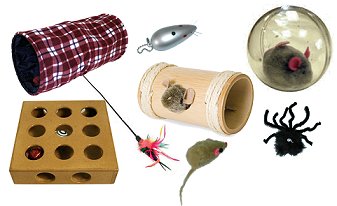
Cats like to play. So if you have a cat, it is a good idea to get some toys for her. This is especially important if the cat stays indoors all the time and does not get the variety and stimulation on offer outside. There is now a huge cat toy industry, with new types of toys regularly turning up on the shelves of pet stores. Different types of toys have a different objectives. For example some toys are for the cat to play with alone, and others are for human and cat to play with together. Play helps to develop stronger bond between humans and their cats, and certainly most cats appreciate interacting with humans.
It is fortunate that various types of toys are available, because not all toys are suitable for all cats. You have probably noticed by now that cats have highly individual characters. They have their preferences and, like humans they may have toys that they use again and again, and others that they get bored with after a while and never play with again. This does not mean that you should rush out and buy everything available in the shop. Indeed it is better to buy one or two toys first and once your cat loses interest in those, get something new.
Cats are often like children when it comes to new toys, in that they are sometimes as happy (or even more happy) playing with the wrapping paper and the box than the toy that came in them. In fact having a couple of larger boxes with holes cut in various places makes a very economical way to entertain your cat, if you have the floor space. Other things your cat may enjoy include paper scrunched up into a ball, a chestnut she can chase around the floor or a piece of string. So experimenting with a home-made toys is a worth-while investment. Some cats get a lot of energetic entertainment from ping-pong balls.
Generally younger cats are more playful than older cats. An older cat may need more encouragement to get into the swing of a game, and some days your cat will just not be in the mood to play. Don’t let it discourage you.
Toys available commercially can be subdivided into several groups:
- toys on a string (feathers, small soft toys, soft balls attached to a rod or a string). These toys are designed for between you and your cat. You can move the toy at the end of the rod from one side to the other, occasionally hiding it behind your back or a table leg. Cats normally can’t resist small, moving objects and will soon start chasing after them. Make sure you let her catch the toy from time to time and wrestle with it.
- different coloured balls. These often have something inside which makes a sound as it rolls along the floor. Some cats really love chasing them around the room. Coloured balls are designed for cats to play alone or with you.
- soft toys, often in a shape of the mouse, which cats can carry around. Many of these toys will give a squeak for additional audio effect. (The good news is that if the insides come out, this is a lot less messy than with a real mouse!)
- a variety of tunnels normally made of crinkly plastic which makes a noise when the cat crawls inside.
- hidden prey toys – these can be in the shape of a box with holes or balls with a hole on one side. The ‘prey’ is put inside the ball. This is usually something edible but not messy – a treat or dry food. The cat will need to get her paws inside or roll the ball to get at what’s inside. If the treat is particularly tasty, the toy should keep the cat busy for some time.
- finally there are gadgets. For example, remote controlled mice, and laser lights etc which again will require human assistance for the game. As cats love chasing things and a remote controlled moue lets you steer the toy from your armchair. (In fact some of these gadgets are as much fun for the human as for the cat.) You can also shine a laser spot on the wall or the floor and move it around. Many cats will love chasing the dot. Make sure that you do not shine the light directly into the cat’s eyes though, as cat’s eyes are very sensitive.
Nowadays many toys contain catnip, which makes the toy much more attractive. Catnip is a herb native to Europe and it has a very stimulating effect on many cats. These cats like to roll over it, kick at it, rub against it, and generally go nuts over it. If you would like to know more about catnip, have a look at ‘Catnip – a designer drug for cats?‘ in the ‘info’ section on this site. Nobody is sure exactly how catnip works but if your cat is affected by catnip, toys with catnip will get the thumbs up. If your cat toys do not have catnip, don’t worry. You can always get a catnip spray and put a whiff over the toy before play time.
You may have to experiment a bit to find out which toys most suit your cat. Coloured balls generally work better with younger cats which have tons of energy to burn and need little encouragement to run around. Hidden prey toys require more skill so they will probably work better with an adult cat than a kitten. Toys on a string or rod are generally good for most cats.

Foto005.jpg)







